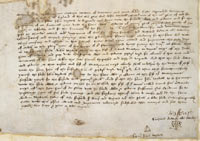 |
 |
 |
 |
 |
 |
 |
|
|
The organisation and staffing of the granges We prohibit any abbot from
entrusting his granges or any one of them
The cellarer oversaw the management of all the abbey's granges. He was an important monastic official (or obedientiary) who resided at the monastery. A resident grangemaster, who was a lay-brother, was directly responsible for the running of each grange, and might be assisted by a helper.(29) He supervised the team of lay-brothers who staffed the grange, and would have employed seasonal local labour when necessary, for example at harvest. If there were a number of lay-brothers, several might be appointed to oversee the various departments at the grange, such as the dairy or forge.(30) Whilst the cellarer and grangemaster between them were responsible for the daily organisation of the granges, it was a monk official known as the master conversi who tended the lay-brothers' spiritual needs. He visited the granges on Saturdays to hear their confessions, and also on the days before they received Communion at the abbey. Changes in the economy, the effects of plague and warfare, and the demise of the lay-brotherhood brought changes in the structure and organisation of the granges. By the later Middle Ages many were leased to lay people, others were farmed as demesne. Fountains was slower than most other Cistercian abbeys to reorganise its economy, but by the fifteenth century a number of the abbey granges were leased to tenants, for example at Cowton, or farmed as demesne by lay keepers, as at Bouthwaite. The abbey's servants might have been well placed to lease lands. In 1512 Robert Dawson and his wife, Ellen, who were keepers of the West Gate at the Fountains, leased land in Aldfield; Marmaduke Wildmen, a tailor of Fountains, also leased land here.(31)
|
